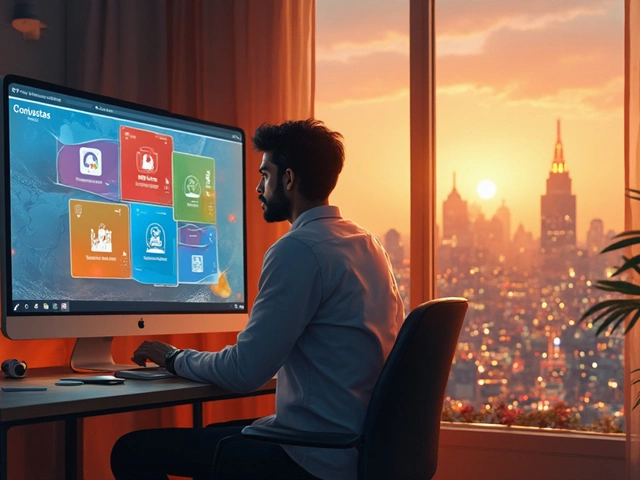Is Indian Online Degree Valid in USA? What You Need to Know
If you’ve ever scrolled through an online diploma course from India and thought, “Can this actually help me in the US?” you’re not alone. It’s easy to get excited about flexible learning and affordable tuition, but that nagging question about recognition keeps popping up. The truth is, not every Indian online degree walks through the doors of a US university or company without some questions asked.
US organizations aren’t just looking for fancy certificates or grades—they want to know if your course comes from a school that actually means business. Accreditation is a word you’re going to hear a lot. Without it, most agencies in America just won’t bother to even check the rest of your resume. And here’s the kicker: even some legit-sounding Indian online courses don’t always tick the right boxes for the US system.
So before you spend your weekends glued to the screen, it’s worth figuring out how these degrees really stack up. Whether it’s for climbing the career ladder or trying to get into a US college later, knowing what counts over there can save you both money and heartbreak. Next, let’s dig into the details—and look at what actually works and what’s just marketing fluff.
- How US Institutions View Indian Online Degrees
- Employer Perceptions and Real-World Challenges
- Accreditation: The Real Dealbreaker
- Tips to Maximize Your Degree’s Value in the USA
How US Institutions View Indian Online Degrees
If you’re banking on your Indian online degree opening doors in the US, you’ll want the details no one tells you at sign-up. US schools and companies are pretty picky about where your qualification comes from and how it’s delivered. For a start, degrees from well-known brick-and-mortar universities in India, like IITs or Delhi University, tend to get more respect—even if you studied online. But lesser-known online-only Indian colleges? That’s when things get tricky.
The first hurdle is called “accreditation.” US institutions check if your college is recognized by India’s University Grants Commission (UGC) or the All India Council for Technical Education (AICTE). If your institution isn’t on their lists, US universities might not even review your application. Some American colleges trust reports from credential evaluation agencies, like WES (World Education Services) or ECE, to compare foreign degrees against US standards.
Here’s what usually happens:
- If your online Indian degree came from a UGC-accredited university, there’s a good chance a US institution will at least give it a fair look.
- If you got your diploma from a private or unapproved online provider, you’ll likely hit a dead end in the US system.
- For master’s and technical programs, US colleges often expect a four-year bachelor’s degree—as many Indian diplomas and distance programs offer only three years, this can be a stumbling block for grad school.
| Type of Indian Institution | US Recognition Rate* |
|---|---|
| Top public university (e.g., IIT, DU) | High (70-90%) |
| UGC-accredited online/distance college | Moderate (40-60%) |
| Private, unaccredited online provider | Low (<10%) |
*Recognition means a US institution may count your degree as equivalent or consider you for further study/employment, based on 2023 data from credential evaluators.
If you’re going for jobs instead of more studies, US employers are a mixed bag. Tech companies might care more about your skills than your degree source, but law firms, hospitals, and government offices usually stick to strict guidelines. Many hiring managers Google your degree or use background check services—if it’s from an unknown or unaccredited college, your application often doesn’t make it past the first round.
The bottom line? Indian online degree programs don’t all have the same weight in the US. To avoid nasty surprises, check accreditation early and see if US credential agencies recognize your course. Don’t just trust online ads—triple-check with official US or Indian education portals before investing your time and cash.
Employer Perceptions and Real-World Challenges
When it comes to jobs in the US, hiring managers care about two things: where you learned and if what you learned actually matters for the role. If you show up with an Indian online degree, you’ll probably run into a mix of honest curiosity and pretty blunt questions.
The biggest hurdle? Name recognition and trust. Most American employers know the IITs and maybe a handful of other top universities in India, but they’re unlikely to recognize DiplomaHub.com or some smaller online college. If your diploma came from one of those well-known institutions—even through an online program—you’ll have an easier time. Otherwise, people may need a nudge to see its value.
Another real-world issue is figuring out if your course content lines up with US standards. For example, a 2024 survey by World Education Services showed that 68% of US employers hesitate when it comes to foreign online degrees because they don’t know the course depth or how much practical hands-on work was included. This often means extra questions or even skill-based tests before you’re considered for the job.
Here’s a quick look at employer attitudes across sectors:
| Industry | Acceptance Rate | Common Concerns |
|---|---|---|
| IT & Tech | High | Practical skills, accreditation |
| Healthcare | Low | Certification, local licensing |
| Business/Finance | Medium | College reputation, course quality |
| Engineering | Medium | ABET or equivalent approval |
Some real tips if you want your degree to get noticed:
- Go for online programs from universities already respected in the US. Names matter.
- Save all records of coursework, projects, or internships—you may need them to prove your skills.
- Consider US-based certification exams (like CompTIA for IT) to back up your diploma.
- Be upfront about your education in your resume and interviews, especially about your degree’s online nature and what you actually learned.
All said, your online diploma can open some doors, but it’s up to you to show why it deserves a place among the local qualifications. Employers may not ask for your transcripts up front, but they will test your skills. That’s the part you actually control.

Accreditation: The Real Dealbreaker
This part isn’t optional. If your Indian online degree isn’t properly accredited, most US schools and employers will give it a hard pass. Accreditation basically means your program is officially recognized by bodies that set the quality bar high enough—think of it like a background check for your college, not you. In India, this usually means the UGC (University Grants Commission), AICTE (All India Council for Technical Education), or NAAC (National Assessment and Accreditation Council). If your online course provider isn’t backed by one of these or a similar government-recognized body, you’re at a dead end before you start.
But here’s where it gets tricky: US institutions don’t just blindly accept anything the UGC or NAAC stamps. They’ll often turn to evaluation agencies like WES (World Education Services) or ECE (Educational Credential Evaluators). These guys compare your degree to US standards and decide if it’s “equivalent” to what someone in the States would get. Sometimes they say yes. A lot of times, especially with fully online or distance learning programs from lesser-known schools, they say no—or recognize it only as “coursework,” not a full degree.
- Before signing up, check if your online Indian school’s accreditations are listed on the official UGC or AICTE websites.
- Look for online programs run by established public universities (like IGNOU, Delhi University, or Anna University), which US evaluators are more likely to accept.
- If you’re aiming for the US job market, stick to degree programs (not short courses), and make sure they include transcripts and syllabi you can submit for evaluation.
- Think ahead: some professional licenses in the States also require your degree to match up with US accreditation standards, which a lot of private online schools in India can’t provide.
Don’t get caught assuming that every online diploma with a government logo is good to go for America. Always double-check accreditation—sometimes that five-minute web search can save you years of hassle.
Tips to Maximize Your Degree’s Value in the USA
If you’re planning to put your Indian online degree to work in the States, there’s a right way (and a wrong way) to go about it. There’s no magic letter that turns your Indian diploma into a US-approved ticket overnight, but there are concrete steps that make a real difference.
- Check Accreditation Before You Enroll: US employers and universities care about where your degree comes from. Make sure the Indian institution you pick is accredited by the University Grants Commission (UGC), National Board of Accreditation (NBA), or is listed in WES (World Education Services) guidelines. Avoid schools that cut corners. If you’re unsure, WES provides a database where you can check if your degree will be recognized.
- Get Your Credentials Evaluated: Most US schools and companies want an official evaluation of your diploma. Groups like WES, ECE, or SpanTran do this for a fee. They’ll compare your coursework, grades, and program level to a similar US qualification. According to WES, in 2023, more than 20,000 Indian online degree holders got their credentials evaluated for US equivalency.
- Highlight Relevant Coursework or Skills: Don’t just say "I have a degree." Get specific about the skills and projects you did. If a job is looking for Java skills and you took two Java online modules, say so. Practical skills matter just as much as the name on the certificate.
- Get Experience or Certification in the US: While your Indian degree is your foundation, a short US-based certification or internship can boost your credibility. For tech jobs, even a few recognized online courses from Coursera, Udemy, or Google can help bridge the gap.
- Network and Find Alumni: Connect with people who’ve already made this jump. Platforms like LinkedIn are packed with Indians who studied online and now work or study in America. Their advice can save you a ton of hassle.
Here’s a quick look at how the process typically plays out for Indian online diploma holders eyeing the US market:
| Step | What It Means | Useful Resource |
|---|---|---|
| Accreditation Check | Make sure your course is recognized in India | UGC/NBA, WES |
| Credential Evaluation | Get your qualifications translated to US standards | WES, ECE, SpanTran |
| Skill-based Applications | Highlight projects, skills, tech stacks | Resume, LinkedIn |
| Additional US Certifications | Add US-specific credentials | Coursera, LinkedIn Learning |
The bottom line? Plan your moves early, pick wisely, and show how your learning actually fits what employers or universities in the US want. One extra weekend of research now saves months of frustration later.





